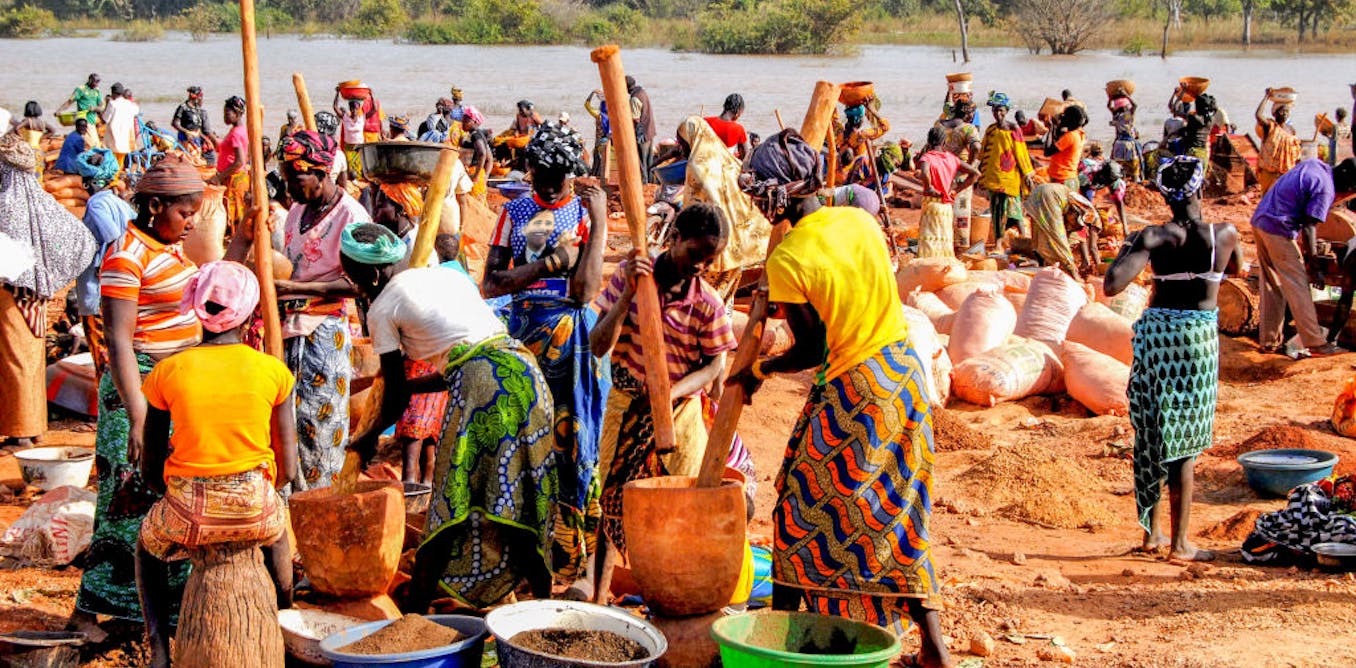The just transition debate centres on how to move away from fossil fuels towards renewable energy systems while safeguarding working conditions, livelihoods, and economic and social rights of workers in industrial sectors.
This debate has mainly focused on paid labour and job security in carbon-intensive sectors. But it overlooks hundreds of millions of people involved in unrecognised work that subsidises these transitions. This “unseen” labour is called “reproductive labour”. It’s work that happens outside the market or formal industrial system but sustains the living conditions of workers in formal labour.
Reproductive labour is primarily associated with the maintenance of the living conditions of the workforce in a capitalistic society. This includes care work, cleaning, food production and healthcare provision. Unpaid work in the household is also integral for understanding reproductive labour.
In general terms, we can say that the life of any worker is made possible through unrecognised and unpaid reproductive labour. Historically this was assigned to women due to heteronormative gender roles.
Based on my academic research on the nexus between the energy transition and the extraction of raw materials needed for clean energy technology, I argue that social reproduction has not been seriously incorporated in the just transition debate. Thus, it’s imperative to apply feminist lenses to it. Doing so would put an eye on the often unrecognised, unpaid and rendered invisible labour that is powering the energy transition.
A feminist lens provides a view of labour regimes connected to the energy transition (in the paid and unpaid economies) and how transition industries (like mining and processing raw material or manufacturing green technology) rely on the exploitation of unpaid or underpaid and marginalised workers. Most often they are women.
A just transition goes beyond “greening” energy systems. It must put social reproduction at the centre of the just transition.
Reproductive and care work subsidies the energy transition, thus making it financially profitable within today’s capitalist system.
Female labour rendered invisible
Industries connected to the energy transition such as industrial mining, processing and the manufacturing of electric batteries are often portrayed as dominated by a male workforce.
But are they truly running on male and formal labour alone?
Quite the contrary. These industries are underpinned by a highly stratified gender division of labour, where poor and racialised women often bear the brunt.
In the first place, what upholds the living conditions for workers to continue their labour? It is reproductive labour. This is not news. The COVID-19 pandemic illustrated how caring economies are essential to reproduce society at large. Any economic sector in the capitalist system has depended heavily on the labour of poor women.
The energy transition, and its associated industries, do so too. And the conditions in which reproductive labour takes place happen under particularly dreadful working conditions.
For example, labour in mining sites in resource-rich countries is highly precarious. Industrial mining tends to rely on artisanal or small-scale miners as mining zones become unprofitable.
Artisanal miners frequently combine and switch between subsistence economies, supported by reproductive labour at the household and community. Women play a central role in the mining industry and outside of it.
According to the Extractive Industries Transparency Innitiative, around 40 million people contribute to artisanal and small-scale mining worldwide. Up to 50% of the global artisanal and small-scale mining workforce is conducted by women.
The mining industry outsources the costs, risks and environmental liabilities to small-scale and artisanal miners. Another case of labour at the outskirts of the formal market economy sustaining global supply of minerals.
Large-scale mining industries are automating and investing in high technologies, often reducing the number of paid workers. As they do so, they are expanding the number of workers involved in reproductive labour. Generally, poor, racialised workers come to mining regions to look for jobs and establish settlements without established support networks.
In such circumstances, they depend on unpaid or exploited, often female, labour in essential economies such as street vending, cleaning, food production and healthcare.
This process has led to rapid changes in the environmental and economic landscapes of extraction sites. It has also been associated with a rise in sex work and violence against women.
In Chile, for example, a leading mining country, industrial mining is connected to the 2007 Subcontracting Law. The law promotes temporary and transient services, eroding workers’ bargaining power and labour rights. Mining workers often rely on food production, cleaning and accommodation services outsourced to private companies.
The lack of welfare benefits can put them in debt too as workers have to pay for these privatised services with their own underpaid wages.
Social relations that maintain the living condition of workers outside the market economy compensate for what’s missing inside the market economy. This reproductive labour, which is highly precarious and often invisible, has not been addressed in the just energy transition debate.
The just transition debate ignores reproductive labour. So is it just?
Putting social reproduction at the centre
Feminist international relations scholars Carol Cohn and Claire Duncanson argue that different feminist questions lead to different policy responses and, consequently, different potentials for impact.
An effective just transition must prioritise care and well-being at all levels and regions. This requires a critical interrogation of the exploitative basis of the energy transition at its current form, which is globally sustained by the cheapening of poor and racialised female labour mainly. Let’s put this lens at the centre of the conversation.
This article is part of a series of articles initiated through a project led by the Southern Centre for Inequality studies, in collaboration with the International Development Research Centre and a group of feminist economists and climate scientists across the world.




